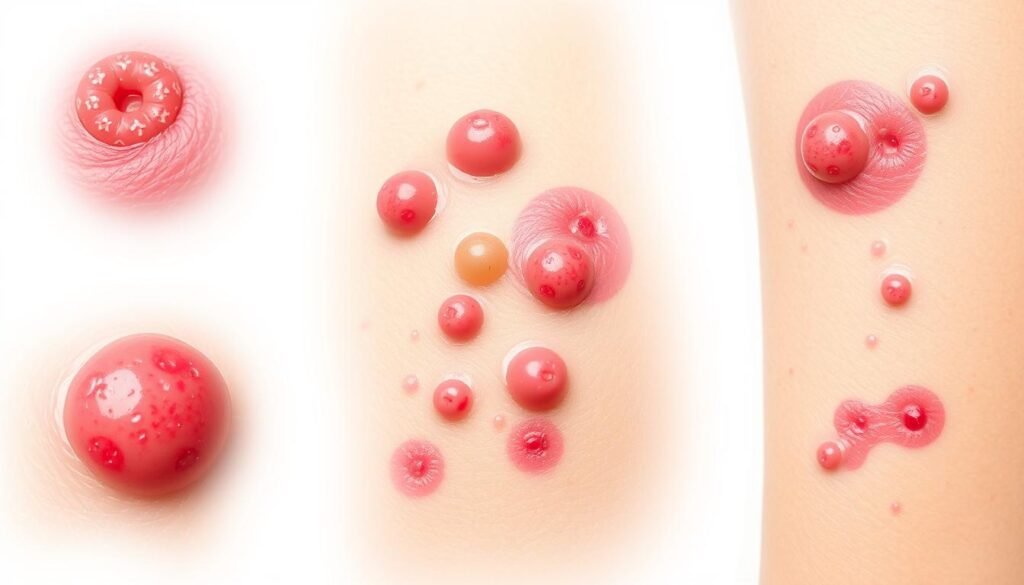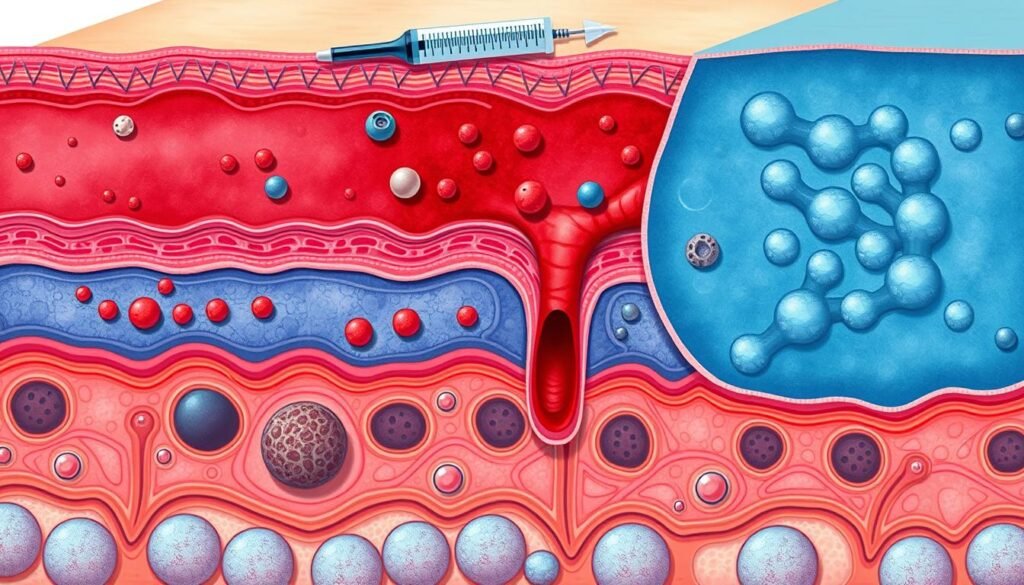Did you know nearly 10% of people will get folliculitis during their life? This skin issue targets the hair follicles, causing inflammation and sometimes painful bumps. It’s essential to know what causes Folliculitis and its risk factors. Many things, including bacterial infections, fungal overgrowth, and lifestyle choices like wearing tight clothes or heavy sweating, can trigger it. Let’s dive into these factors to better understand how this inflammation happens. We’ll also discuss how to reduce the risk.
Key Takeaways
- Folliculitis affects about 10% of the population.
- Main causes include Bacterial Infections, Fungal Overgrowth, and Blocked Hair Follicles.
- Awareness of risk factors can aid in prevention.
- Inflammation of hair follicles can cause discomfort and skin problems.
- Lifestyle choices significantly impact folliculitis development.
Understanding Folliculitis
If you’re dealing with skin discomfort and irritation, getting to know about folliculitis is crucial. This common issue happens when hair follicles get inflamed. It often leads to itchy or painful bumps. Knowing about this can help you act fast if you see the signs.
The symptoms can be as mild as redness or as severe as pus-filled blisters. Sometimes, it can even scar the skin, which is upsetting. The way it changes the skin and causes discomfort can really affect how someone feels about themselves. It’s important to catch and treat these symptoms early.
Folliculitis has both shallow and deep types. The shallow kind only affects the top part of the hair follicle. The deep kind can cause bigger skin problems. Knowing the difference is key to finding the right treatment.
Learning about folliculitis highlights why skin care is so important. With the right preventive steps, people can keep their skin healthy and happy. This helps avoid the trouble that comes with this condition.
What is Folliculitis?
Folliculitis is a skin condition that causes inflammation around your hair follicles. It mainly comes from a Follicle Infection, caused by bacteria like Staphylococcus aureus. Fungi can also be a problem, creating different symptoms.
This issue can appear on any part of your body with hair. That includes your scalp, face, and arms. You might see red bumps or pustules, feel tenderness, and have an itch. Without proper treatment, it can lead to scars or even permanent hair loss.
To manage what is Folliculitis well, keeping clean is very important. For more details, check out this detailed resource.
Causes and Risk Factors of Folliculitis
Understanding what leads to folliculitis is key for prevention. This condition comes from various factors that irritate hair follicles. This causes them to become inflamed and infected.
Bacterial Infections
Bacteria cause most cases of folliculitis. They get into hair follicles through small cuts or scrapes. Staphylococcus aureus is a common one found on our skin. Taking care of your skin’s health helps lower the risk of these infections.
Fungal Overgrowth
Fungi grow well in damp and warm spots. This makes areas like armpits and groins perfect for infections. Wash these areas well to keep fungi away and protect your skin.
Blocked Hair Follicles
Shaving wrong, too much oil, or using thick lotions can clog hair follicles. This trap for bacteria and fungi can cause inflammation or infection. Watching your daily skin care can help keep follicles open. This prevents folliculitis.
| Cause | Description | Prevention |
|---|---|---|
| Bacterial Infections | Infections caused by bacteria, often entering through skin abrasions. | Maintain proper skin hygiene and treat any cuts promptly. |
| Fungal Overgrowth | Infections resulting from excess fungi in warm, moist areas. | Keep skin dry and clean, particularly in vulnerable regions. |
| Blocked Hair Follicles | Follicles clogged by oil, dirt, or improper shaving techniques. | Use light moisturizing products and shave gently. |
Learning more about Causes and Risk Factors of Folliculitis can better your prevention tactics.
Common Symptoms of Folliculitis
It’s key to spot folliculitis early for good care. The condition shows up as skin changes, hinting at irritation. If you have it, you might notice several warning signs.
Identifying Skin Irritation
Skin irritation is the main sign of this issue. Look out for these symptoms:
- Redness: Swollen patches on the skin are a clear signal.
- Itching: You might feel a constant need to scratch those spots.
- Pus-filled blisters: Little bumps filled with fluid might pop up, looking like pimples.
Getting to know these symptoms is a step towards prompt help. Don’t wait to get advice from a doctor if you see these signs. Acting quickly helps in managing it well.

| Symptom | Description |
|---|---|
| Redness | When the skin gets inflamed and changes color. |
| Itching | Feeling like you need to scratch the bother area. |
| Pus-filled blisters | Tiny, sore bumps that might break open. |
Impact of Shaving Irritation
Shaving is a popular way to remove hair, but it can cause shaving irritation. This irritation appears as redness, bumps, or itching, harming the skin. The issue starts when shaving creates tiny tears in the skin. These tears may let bad germs enter and increase the chance of folliculitis.
Understanding what causes folliculitis from shaving is important. There are a few main reasons:
- Not changing old or dull razors, which leads to more friction.
- Shaving against the grain, which harms skin more.
- Forgetting to clean the skin before shaving, letting bacteria grow.
To keep irritation low and avoid problems like folliculitis, right shaving ways matter. Here are good tips:
- Always use a clean, sharp razor. This makes shaving smoother.
- Get your skin ready with warm water and good shaving cream.
- Shave the way your hair grows. It’s gentler on your skin.
- Use aftershave for sensitive skin to calm any redness.
Following these steps can help lower the risk of shaving irritation. It also prevents problems like folliculitis from happening.
The Role of Tight Clothing
Tight clothes can lead to skin irritation known as folliculitis. When clothes are too snug, they rub against the skin. This rubbing can clog hair follicles, especially for those with skin concerns. It’s key to know this for better skin care.
How Tight Clothing Contributes to Folliculitis
Wearing tight clothes during exercise raises folliculitis risk. Such clothes can trap heat and moisture, making skin problems worse. Plus, synthetic materials like polyester add to the problem due to their tight weave.
- Friction: Tight clothing causes fabric to rub the skin, leading to inflammation.
- Moisture: Sweat and air blockage can clog pores.
- Material Matters: Synthetic fabrics increase friction and trap heat.
To avoid these risks, pick loose, airy clothes for physical activity. Choose fabrics that keep moisture away to protect your skin. Remember, skin health is important. Including biotin-rich foods in your diet can also help. Making smart clothing choices reduces the chance of getting folliculitis. By taking these steps, you can enjoy healthier skin without irritation.
Excessive Sweating: A Contributing Factor
Excessive sweating is also called hyperhidrosis. It greatly increases the risk of folliculitis. The moisture from sweat creates the perfect place for bacteria and fungi.
When it’s hot or after intense exercise, this risk goes up. People with hyperhidrosis need to watch out for their skin. Sweat and bacteria together can block hair follicles. This leads to folliculitis.
To prevent this, it’s crucial to keep the skin clean and dry. A few steps can help keep the skin healthy and fight off issues.
- Maintain cleanliness: Regularly showering, especially after sweating, helps to remove sweat and bacteria.
- Use breathable fabrics: Clothing made from natural materials promotes airflow and helps manage moisture.
- Stay hydrated: Drinking plenty of water can help regulate body temperature and potentially reduce sweating.
By following these tips, you can lower your chances of getting folliculitis from too much sweating.
| Management Strategy | Description | Benefits |
|---|---|---|
| Maintain cleanliness | Shower frequently to remove sweat and bacteria. | Reduces bacterial growth and clogged pores. |
| Use breathable fabrics | Wear clothing made from natural materials. | Improves airflow, decreases moisture. |
| Stay hydrated | Drink adequate water throughout the day. | Helps regulate body temperature. |
Weakened Immune System and Folliculitis
Having a weak immune system can make you more likely to get folliculitis. This is when the hair follicles on your skin get inflamed. People with weakened immune systems, like those with HIV/AIDS or diabetes, have a harder time fighting off infections. This makes them more prone to skin issues. Knowing about this Folliculitis Connection is key to taking care of your skin.
How Immunocompromised Status Affects Skin Health
If your immune system isn’t strong, your skin can’t defend itself well. This makes it easy for infections to happen. Your skin might face several challenges:
- Bacteria can grow more on the skin, increasing the risk of folliculitis.
- Fungal infections find a welcoming environment when immune defenses are low.
- Wounds on the skin can heal slowly, possibly leading to folliculitis.
It’s important to take care of your overall health. Keep an eye on your health status. Always talk to your doctors about how to keep your skin healthy.
| Health Condition | Impact on Immune System | Potential Skin Issues |
|---|---|---|
| HIV/AIDS | Severely affects immune function, reducing defense against infections | Higher risk of various skin infections, including folliculitis |
| Diabetes | Impaired circulation and immune response can occur | Increased risk of bacterial and fungal infections |
| Corticosteroid Use | Suppresses immune response | Higher susceptibility to skin infections |

Hot Tubs and Pools: Assessing the Risks
Relaxing in hot tubs and pools can be great. But, there’s a downside like folliculitis. The warm, still water helps bacteria and fungi grow. This can make skin infections more likely. It’s essential to check how well places keep their facilities clean to reduce folliculitis risk factors.
Here’s some important info about hot tub and pool safety:
| Factor | Hot Tubs | Pools |
|---|---|---|
| Water Temperature | Hot temperatures can foster bacterial growth. | Typically cooler, reducing the risk. |
| Chlorination | Must be regularly monitored to ensure effectiveness. | Consistent chlorine levels help prevent infections. |
| Filtration | Should be frequent to eliminate contaminants. | Regular filtration is essential for water clarity. |
| Usage Time | Prolonged exposure increases infection risk. | Shorter sessions are generally safer. |
Want to stay safe while using these fun spots? Follow these tips:
- Always check the cleanliness and maintenance records of hot tubs and pools before using them.
- Shower before entering to minimize the introduction of new bacteria.
- Avoid using hot tubs if experiencing any skin irritations or open wounds.
- Limit time spent in hot tubs, especially during peak usage periods.
Diabetes and Its Connection to Folliculitis
Understanding the connection between Diabetes and Folliculitis is crucial. High blood sugar can lead to infections including those in hair follicles. Those with diabetes often face harder battles against infections due to weaker immune systems.
For diabetics, keeping skin healthy is important. High sugar in the blood can cause skin issues, increasing folliculitis risk. It’s key to watch your blood sugar closely and keep it stable.
Regular check-ups are a must for anyone with diabetes. These visits can provide personalized tips to control your diabetes. This helps reduce the chance of getting folliculitis among other complications.

| Aspect | Diabetes Impact | Folliculitis Risk |
|---|---|---|
| High Blood Sugar | Weakens Immune System | Increases Susceptibility to Infections |
| Skin Changes | Causes Dryness and Irritation | Promotes Follicle Blockage |
| Infection Risk | Elevates Chances of Complications | Facilitates Folliculitis Development |
Being proactive about diabetes management can help prevent folliculitis. Taking care of your skin is a key part of managing diabetes well.
Prevention Tips to Reduce Risk
To lower the chances of getting folliculitis, it’s key to follow some prevention tips. Good skin care practices and the right clothing can make a big difference. This helps reduce the risk of troublesome skin issues.
Adopting Healthy Skin Care Practices
Having a good skin care routine is a strong defense against folliculitis. Use products that don’t clog pores and wash your skin often. Avoid harsh soaps and lotions with lots of chemicals. Click here for more skin care.
Exfoliating regularly makes your skin smooth and prevents clogged follicles. This step is important in keeping skin clear.
Choosing Appropriate Clothing
What you wear matters too in preventing folliculitis. Go for clothes that let your skin breathe to lower irritation and risk. Cotton and other airy fabrics are best because they’re comfortable and breathable.
Avoid tight clothes as they can trap moisture and lead to bacteria growth. Choose loose clothes to keep your skin happy and healthy.
| Practice | Description |
|---|---|
| Non-comedogenic Products | These products do not block pores, helping to maintain clear skin. |
| Regular Exfoliation | Removing dead skin cells can prevent blocked follicles. |
| Loose-fitting Clothing | Selecting breathable fabrics minimizes skin irritation. |
| Proper Hygiene | Consistent cleaning routines help prevent bacterial and fungal growth. |
Conclusion
Knowing why folliculitis happens is crucial for stopping and treating it. Things like bacteria, sweat, and weak immune systems cause hair follicle swelling. Wearing tight clothes and shaving often can also make it worse.
To lower folliculitis risk, being aware of health matters a lot. Choose what you wear and how you care for your skin wisely. Knowing about skin health and spotting symptoms early can lead to quick and effective treatment.
The fight against folliculitis starts with being informed. For deeper understanding, check this article. Staying ahead and being proactive is key to better skin health.
